Description
MarkNature FCCIV-grade Maltol stands as a pinnacle of quality, synthesized with precision to meet the highest industry standards. Comprising the chemical formula C6H6O3 and boasting a molecular weight of 126.11, this compound, also known as 3-Hydroxy-2-methyl-4-pyrone, embodies purity and reliability. Maltol, obtained through meticulous chemical synthesis, exhibits a melting point range of 160~164 ºC, ensuring consistency in its properties. While sparingly soluble in water, its solubility in ethanol and propylene glycol makes it remarkably versatile for various formulations.
CAS No.: 118-71-8
EINECS No.: 204-271-8
FEMA No.: 2656
Chemical Formula: C6H6O3
Molecular Weight: 126.11
Synonyms: 3-Hydroxy-2-methyl-4-pyrone
Standard: FCCIV
Description: Maltol is obtained by chemical synthesis
Melting Point: 160~164 ºC
Solubility: Sparingly soluble in water,
Soluble in ethanol and in propylene glycol
Specification:
Appearance: White powder or needle crystals
Odor: Characteristic caramel butterscotch odor
Assay: 99.0% min.
Moisture: 0.5% max.
Residue on ignition [sulfated]: 0.2% max.
Cadmium [Cd]: 1ppm max
Mercury [Hg]: 1ppm max
Heavy metals [Pb]: 10ppm max.
Arsenic [As2O3]: 3ppm max.
Key Features:
- High Purity FCCIV Grade: Our Maltol complies with FCCIV standards, guaranteeing superior quality and purity for diverse applications.
- Precision Synthesis: Meticulously synthesized to ensure consistency in properties and performance, meeting stringent industry requirements.
- Wide Solubility Profile: While sparingly soluble in water, its solubility in ethanol and propylene glycol enhances its applicability in different formulations.
- Defined Melting Point: With a specific melting point range of 160~164 ºC, ensuring product integrity and stability.
Applications:
Maltol, an essential compound in the realm of food and fragrance industries, finds diverse applications owing to its unique properties. In the food sector, it functions as a flavor enhancer, adding a caramel-like taste to a variety of products, including confectioneries, baked goods, beverages, and more. Its inclusion in fragrance formulations contributes to a sweet, caramel aroma, elevating the olfactory experience in perfumes, cosmetics, and toiletries. Additionally, Maltol serves as a key ingredient in pharmaceuticals, leveraging its properties for taste-masking or enhancing the palatability of medicines, syrups, and oral care products. Its versatility in various industries underscores its significance as a valuable component in formulation and product development, meeting the demands for quality and sensory appeal.

